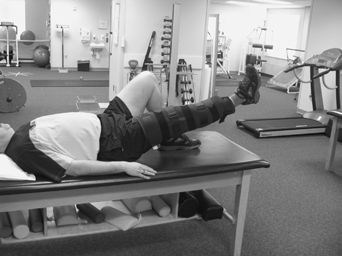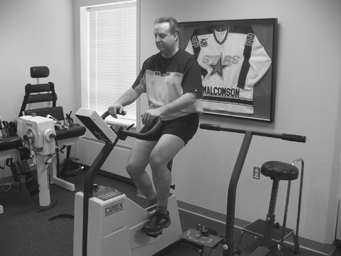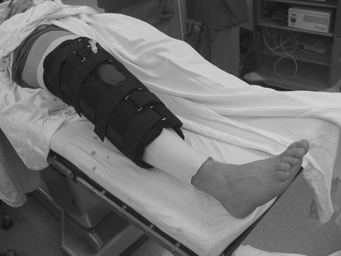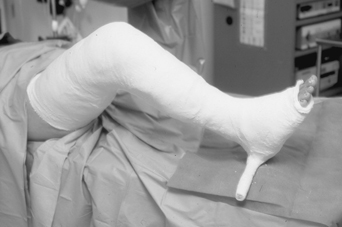8 The rehabilitation principles for the treatment of posterolateral corner knee injuries differ for isolated versus combined posterolateral corner injuries and for acute versus chronic posterolateral knee injuries. The treatment of these injuries is continually evolving. In my training, I was told by the late Dr. Jack Hughston that all patients need to be treated in a long leg cast with a pelvic band around their waist, as well as a strut at the base of their foot to prevent external rotation, for a minimum of 4 to 6 weeks after any type of primary repair or reconstructive procedure, or there would be a very high risk of these repairs stretching out over time (Fig. 8-1). Although my early treatment protocols utilized the information that I had synthesized from my sports medicine fellowship at the Hughston Clinic, I realized that it was important to look at the surgical reconstructive outcomes from other surgeries around the knee that had evolved over time. I found that the treatment of anterior cruciate and medial collateral ligament injuries had also evolved from placing patients in a cast for a period of time to prescribing accelerated rehabilitation. With this in mind, I sought to develop a more joint-friendly and patient-friendly rehabilitation protocol to treat these complicated knee injuries. I was very fortunate in that I had a high volume of injuries to treat in all of these categories, which allowed me to glean information from various patients and their outcomes to determine a proper and safe rehabilitation protocol to follow. This chapter reviews these postoperative rehabilitation protocols for the treatment of various posterolateral corner injuries. Figure 8-1. A right knee treated in a long leg cast with a dowel rod to prevent external rotation at the foot. The treatment of isolated acute posterolateral corner injuries depends on the amount of instability and the need for surgical intervention. For those patients who are found to have grade 1 or 2 posterolateral corner injuries, the current recommended treatment is to proceed with a nonoperative protocol.1 These patients are treated in full knee extension, in a knee immobilizer, for a period of 2 to 3 weeks to allow for healing of the injured tissues. After this time period, they are then allowed to work on a gentle, progressive range-of-motion program as tolerated and to increase their functional activities as tolerated. During the time that they are immobilized in full extension, they are allowed to toe-touch weight bear with the use of crutches, as well as to perform quadriceps setting exercises and straight leg raises in the immobilizer only, several times daily. It is recommended that patients work on a minimum of three sets of 10 repetitions of these individual exercises daily in the immobilizer to prevent the quadriceps muscles from shutting down, which would lead to the development of quadriceps inhibition and joint effusions. As I have noted previously, the results of nonoperative treatment of grade 3 posterolateral corner injuries is fairly dismal.1,2 Although it is recognized that only a small number of patients need nonoperative treatment initially due to skin abrasions, open lacerations, infections, skin degloving type injuries, or other local or systemic issues, the vast majority of acute posterolateral corner injuries can be surgically repaired or reconstructed within the initial 2 weeks after injury. The main goal of any acute reconstructive procedure of the posterolateral corner of the knee is an anatomic repair that allows patients to initiate an early range-ofmotion program. Ideally, I try to have them obtain full extension and a minimum of 90 degrees of knee flexion during the initial 2 to 3 weeks postoperatively. The tissues of patients who cannot be operated on within the first 2 to 3 weeks usually cannot be repaired without significant tension due to tissue retraction or an intra- substance necrosis of the tissues that does not hold sutures well. In these patients, we determine at the time of the surgical procedure what safe range of motion will be acceptable postoperatively. We then place the patient postoperatively into a hinged knee brace that is locked into this set range of motion.3 Patients are then allowed to work within this range of motion for the initial 2 to 3 weeks after their surgical repair, or acute reconstructive procedure, and after that time are allowed to increase their range of motion as tolerated. Overall, patients who undergo an acute posterolateral corner repair or reconstruction procedure are not allowed to bear weight on their operative extremity for a minimum of 6 weeks postoperatively. In addition, due to the potential deleterious effects of hamstring contraction on the posterolateral knee repair, they are not allowed to do any isolated open chain hamstring exercises for the initial 4 months postoperatively. It is recognized that the recommendation for avoidance of hamstring exercises is primarily based on anecdotal information that has been handed down from surgeon to surgeon over time, but avoidance of these hamstring exercises is fairly universal across most major centers that treat these injuries, and there appears to be no long-term deleterious effects of avoidance of these exercises in the initial 4 months after surgery. In addition, a recent study by Markolf et al4 has demonstrated that quadriceps loads do increase the forces on the posterior cruciate ligament at knee flexion angles greater than 30 degrees. In light of this, I would recommend that these exercises continue to be avoided in the initial 4 months after an acute repair or reconstruction to avoid any stretching out of the operative procedure from the hamstrings pulling against the surgical repair or reconstruction. From 2 weeks to 6 weeks postoperatively, patients are allowed to work on regaining a full range of motion of their knee. It is important that they not excessively stress their repair by trying to regain a full range of motion during this time, but it is also important to make sure that patients do not have any problems with arthrofibrosis. I have found that arthrofibrosis is a much less frequent occurrence among posterolateral corner injuries than among medial-side knee injuries. For this reason, if there is any doubt about whether sutures can hold structures after a primary repair, then one runs a small risk of having knee stiffness develop if range of motion is not initiated until 2 to 3 weeks postoperatively, unless there is a concurrent medial-side knee injury that has been addressed surgically. During the time that patients are non-weight-bearing but allowed to work on range of motion, they work on straight leg raises and quadriceps setting exercises in an immobilizer in full extension several times daily (Fig. 8-2). They are also allowed to remove their knee immobilizer to work on regaining their knee range of motion. They should not work extremely aggressively on regaining their range of motion, as this could cause stretching out of their surgical repair or reconstructive procedure during this initial healing phase after surgery. At 6 weeks postoperatively, patients are allowed to slowly and progressively increase their weight bearing as tolerated and they may wean themselves off of crutches when they can walk without a limp. This usually takes 1 to 2 weeks after they are allowed to progressively increase the weight bearing on the operative extremity. I have found that those patients who can increase their weight bearing to the point where they can wean themselves off of crutches within a couple of days postoperatively have been cheating on their weight-bearing protocol rather than keeping the operative extremity non-weight-bearing during the required time frame. Once patients are allowed to increase their weight bearing with the use of crutches, they are also allowed to work out on an exercise bike (Fig. 8-3). In general, we limit patients’ use of the bike to approximately 5 minutes for the first week with no resistance, and then slowly progressively increase the resistance and time on the cycling exercise over the course of the next several weeks. The main goal of the biking program for the first week should be primarily to work on regaining a full fluid range of motion of the operative knee rather than working on any significant quadriceps strengthening. Figure 8-2 A patient performing a straight leg raise in a knee immobilizer in full extension. Figure 8-3 A patient working out on an exercise bike. In addition to the quadriceps strengthening that is regained through the use of the exercise bike, patients are also allowed to perform leg presses. In general, we allow them to utilize one quarter of their total body weight for the use of the leg press but not to flex their knee more than 70 degrees because of the cam effect of the posterior aspect of the femoral condyles on the posterior aspect of the knee. It is believed that this effect may increase the stress on the healing repair or reconstructive procedure. Frequent repetitions using the leg press within these weight limits are performed, with the nonoperative, uninjured extremity serving to back up the operative knee to make sure that excessive stress is not placed on the operative knee if it becomes fatigued while performing these exercises. In addition to the use of the physiotherapy regimens of biking and leg presses, patients are also allowed at this time to increase their walking, as tolerated, and to swim freestyle usually using a kickboard. Patients are not allowed to perform the breaststroke or butterfly stroke yet, or to perform flip turns, to make sure that they are not putting any extra stress on their operative knee. Patients generally follow this same conservative rehabilitation program during the initial 3 months postoperatively. They are being regularly followed to make sure that they are not having any increase in varus laxity or posterolateral rotation during the rehabilitation process. In general, most patients who follow this process have a tighter knee to varus stressing and posterolateral rotation at 3 months postoperatively than is seen in the contralateral normal knee. I allow them to return to a more aggressive rehabilitation program at 3 months, including jogging, more aggressive cycling, and increasing the weight on their leg presses. For the jogging program, patients are allowed to jog between 400 and 800 m on the first day and then they should primarily work on a walking program. If they do not notice any significant increase in pain or swelling of their knee after this initial trial, they may increase the total distance that they jog by 400 m a day until they reach a distance of 3 km, at which point they should work on a steady maintenance program of running at this distance until their knee feels more normal. They may then progressively increase their running distance up to a total of 5 km/day at 4 months postoperatively. In addition, at this time they may work up to 30 minutes/day on an exercise bike or elliptical trainer with increasing resistance as tolerated. I generally tell my younger patients that they should work as hard on the bike as they can tolerate, to the point that when they stop their legs should feel drained, but they should not feel excessively light- headed. For those older patients or patients with a history of cardiac disease, it is recommended that they consult with their primary care physician or cardiologist prior to working on this aggressive rehabilitation program. In addition, during this period, they are allowed to work on leg presses to a maximum of 70 degrees of knee flexion, with the total weight increased as tolerated. In patients who exhibit some mild increase in laxity on their exam, a medial compartment unloader brace is used to provide backup stability to the posterolateral surgical procedure. One rehabilitation program cannot be used for all patients. In patients in the semiacute phase after injury, which is usually 4 to 6 weeks after injury, before they become chronic, there is still a chance of obtaining a primary repair as part of the operative treatment. However, the tissues are usually more significantly retracted, and suture repairs of the posterolateral structures are much more difficult. In the small subgroup of patients who may be treated, it may be appropriate to place them in a cast postoperatively for 2 to 3 weeks to make sure that they have interval healing of their primary repair technique and that they do not stretch out. I progress with their rehabilitation much more slowly than in those patients who can be treated more acutely and obtain a near-normal “safe zone” of knee range of motion after a primary repair of the torn posterolateral structures. Acute, combined posterolateral corner knee injuries usually occur with a combined anterior cruciate or posterior cruciate ligament injury. In most other patients, there is a knee dislocation that usually needs to be treated postoperatively based on the individual findings at the time of surgery rather than on a cookbook type of generic rehabilitation protocol. In general, the treatment of a combined posterolateral corner and cruciate ligament surgery is guided during the initial 6 weeks postoperatively by the posterolateral corner injury. In acute anterior cruciate ligament and posterolateral corner knee injuries, it is desirable to allow patients to obtain full knee extension immediately after the surgical procedure. Of course, there are some instances where the posterolateral corner repair may limit the amount of knee extension that can be obtained. Once again, the surgeon can determine the safe range of motion that can be achieved intraoperatively for this combined knee ligament injury complex, without undue tension on the posterolateral corner repair procedure. It is generally desirable to obtain a range of motion of between 0 and 90 degrees within the first 2 to 4 weeks postoperatively after these combined ligament surgeries. During this time, patients are kept non-weight-bearing to prevent any increased stress on the posterolateral corner surgery. Patients are encouraged to perform quadriceps setting exercises and straight leg raises only in their immobilizers four to five times daily during this 6-week period. After the initial 6 weeks postoperatively, patients are then allowed to progressively increase their weight bearing as tolerated and they may wean off crutches when they can walk without a limp. It is at this time that we treat these patients’ as “day 1” isolated anterior cruciate ligament reconstructive knees and rehabilitate them accordingly. They are allowed to wean themselves off crutches when they can walk without a limp and to slowly increase their resistive exercises based on their overall strength and endurance. The use of an exercise bike, a general walking program, and leg presses to a maximum of 70 degrees of knee flexion is encouraged in the initial 6 to 12 weeks postoperatively for these combined ligament injuries. At 3 months postoperatively, they are allowed to increase their strengthening and to jog, based on their overall operative limb strength and the stability of their posterolateral knee repair. In general, patients take 2 to 3 months longer to recover from an acute combined anterior cruciate ligament and posterolateral corner repair surgical procedure than from an isolated anterior cruciate ligament reconstructive procedure. The posterolateral corner reconstructive procedure reconstructs the fibular collateral ligament, popliteus tendon, and popliteofibular ligament. These structures are important functionally to prevent abnormal varus opening, external rotation, and posterolateral rotation of the injured knee.5–10 For this reason, it is important during the early postoperative rehabilitation period (6 to 8 weeks) that extra stress is not placed on these grafts by knee motions that could cause the grafts to stretch out. The grafts may not yet have healed in their bony tunnels. It is also important to make sure that the patient has appropriate muscle strength to prevent abnormal motion of their knee. It is well recognized that the function of knee ligaments is not to provide stability of the knee except in excessive amounts of knee motion. In general, patients should have strong musculature around the knee and have the muscles, rather than the knee ligaments, hold the knee together during the majority of their activities of daily living. If patients need to have the reconstruction knee ligament grafts hold their knee together during the initial few weeks to months after a surgical procedure, before their muscles are strong enough to hold their knee together, there is a very high risk that the reconstructive grafts may stretch out over time. The analogy that I describe to patients is taffy stretching out once it is pulled, or a metal coat hanger being bent back and forth and slowly breaking; similarly, these grafts suffer fatigue with these particular motions. The overall rehabilitation program that we utilize for our posterolateral corner reconstructions serves as a general guideline to patients who undergo this procedure (Table 8-1). This rehabilitation program may need to be modified for each patient’s circumstances.
Rehabilitation of Posterolateral Corner Knee Injuries and Related Surgeries
♦ Isolated Acute Posterolateral Corner Injuries
♦ Acute Posterolateral Corner Surgical Rehabilitation


♦ Treatment of Acute, Combined Posterolateral Corner and Other Knee Ligament Injuries
♦ Treatment Protocols for Chronic Posterolateral Corner Knee Injuries
Postoperative Rehabilitation for the Posterolateral Corner Reconstruction Procedure
| General Overview |
| The posterolateral corner knee reconstruction reconstructs the popliteus tendon, the popliteofibular ligament, and fibular collateral ligament. These structures function to prevent abnormal varus opening, external rotation, and posterolateral rotation of the injured knee. Thus it is important during the early postoperative period that extra stress not be placed on these grafts with these motions so as not to cause them to stretch out until they have healed in their bone tunnels and the patient has appropriate muscle strength to prevent abnormal motion of their knee. This rehabilitation program serves as a general guideline for patients who undergo this reconstruction, but it should be individualized, especially if there is other concurrent knee ligament surgery. |
| Early Postoperative Modifying Factors |
|
| Postop Week 1 to 2 |
|
| Postop Weeks 3 to 6 |
|
| Postop Weeks 7 to 12 |
|
| Postop Weeks 13 to 16 |
| Goals: |
|
| Exercise Program: |
|
| Postop Months 4 to 6 |
| Goals: |
|
| Exercise Program: |
|
| Postop Months 7 and Later: |
|
The main modifying factor that should occur during the initial portion of the rehabilitation program is that the patient remains in the knee immobilizer at all times other than when he or she is working on knee motion or performing quadriceps exercises. Patients should not come out of the immobilizer until they can perform a straight leg raise without a sag. In addition, patients should remain non-weight-bearing through the end of week 6 after this reconstructive procedure. It is also important to emphasize to patients that they should avoid external rotation of their foot and ankle, especially when they are sitting for periods of time, so as not to potentially stretch out their posterolateral corner reconstruction. Both Dr. Jack Hughston and Dr. Glenn Terry of the Hughston Clinic emphasized the importance of avoiding this situation during the early healing phases postoperatively. Similarly to the rehabilitation principles for an acute repair or reconstruction of posterolateral knee injuries, it is also recommended that progressive hamstring strengthening exercises be avoided during the initial 4 months postoperatively to avoid extra posterior and posterolateral rotatory stresses being applied to the healing reconstruction tissues.











